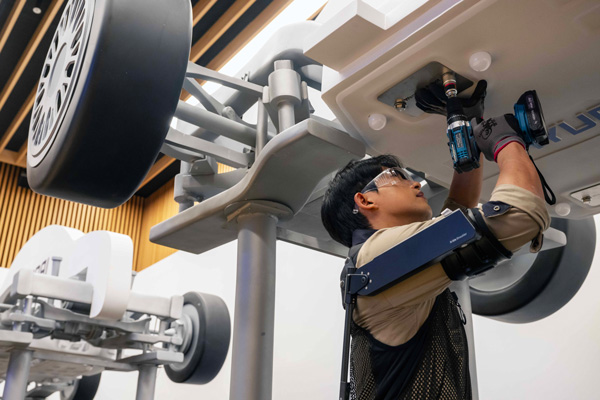
Hyundai Motor Company and Kia Corporation have unveiled the ‘X-ble Shoulder’ – an ‘industrial wearable robot’ device designed to increase workers’ efficiency and reduce musculoskeletal injuries.
The companies say the X-ble Shoulder can reduce shoulder load by up to 60 per cent and anterior/lateral deltoid muscle activity by up to 30 per cent. It generates assistive force through a muscle compensation module via a patented multi-link structure. Each link in the multi-link can be adjusted to deliver the best assistive force in various work environments. The module is expected to perform around 700,000 folding and unfolding actions yearly in industrial settings.
The X-ble Shoulder comes in two versions: basic and adjustable. The companies say the basic version is best for tasks where the posture is not fixed and continues to change and offers up to 2.9kgf (kilogram-force) of assistive force. The adjustable version, for tasks that repeat the same movement, allows users to set the angle for maximum torque based on their work posture, providing up to
3.7kgf of assistive force.
The X-ble Shoulder carbon composite material and wear-resistant material used in high-end vehicles. The parts that directly touch the user’s body are designed to protect against bodily injury that can occur in industrial sites by applying impact-resistant material.
The X-ble Shoulder, the first product in what the companies are calling its X-ble line, is expected to find use in various industries, including construction, shipbuilding, aviation and agriculture, not just automotive. Following its domestic launch, the Hyundai and Kia plan to gradually expand sales to overseas markets.
In addition to the X-ble Shoulder, the companies plan to develop an industrial wearable robot ‘X-ble Waist’ to assist the waist when lifting heavy loads, and a medical wearable robot ‘X-ble MEX’ for the rehabilitation of the walking impaired.
“The X-ble Shoulder is a wearable robot that leverages the technical capabilities of the Robotics LAB and implements feedback from actual users,” said Dong Jin Hyun, Vice President and Head of Robotics LAB at Hyundai Motor and Kia. “Going forward, we aim to expand the availability of wearable robots, creating products that work naturally with users to enhance their daily lives. By pushing technological boundaries, we will make these beneficial products accessible to more people.”
Source: Motor Trader e-Magazine (December 2024 / January 2025)
22 January 2025
